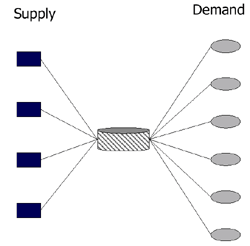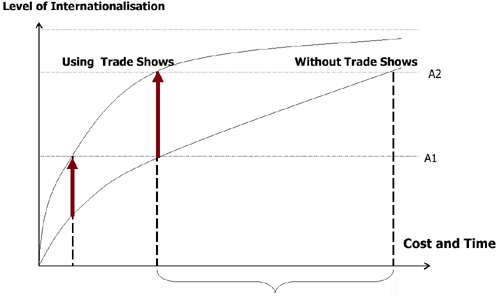| You are
here: Export
Marketing > The Role of Trade Fairs as a marketing tool |
|
|
|
The
Role of Trade Fairs as a marketing tool
What are trade fairs?
Trade fairs are time- and (often) sector-defined marketing
events at which the fundamental products and innovations
of an industry or sector are exhibited by a variety of
companies referred to as exhibitors and which are targeted
at interested buyers and industry participants- the visitors.
These trade fairs are usually organised by government,
chambers, industry associations, or by specialised exhibition
companies.
Trade fairs represent a real-time, interactive environment
bringing together supply and demand in a certain industry.
They promote the formation and growth of markets and market
segments and one can distinguish three economic functions
of trade fairs, namely the exchange of goods, the sharing
of information and the promotion of products and organisations.
The figures below show how trade fairs facilitate the
exchange process.
 |
 |
|
Situation without trade fairs
|
Using trade fairs
|
Source: Rowena Arzt – April 27th, 2006 – Deutsch-Polnisches
Wirtschaftsforum
Trade fairs come in different forms
Trade fairs differ markedly from one another. Some are
specialised; others general. Some have an industry focus;
others have a consumer focus. Some are local; others international.
Some are aimed at buyers; others at sellers. The table
below provides a broad classification of trade fairs.
|
Characteristics |
Type of trade fair |
|
Origin of participants |
Local, regional, national or international trade
fairs |
|
Range of goods offered |
Universal/general, special interest or industry-specific |
|
Type of goods |
Consumer goods or industrial goods |
|
Involved associations |
Chambers, governments, international organisations,
industry associations, specialised exhibitions firms |
|
Direction of Sales |
Import/buying or export/selling |
|
Principal Task |
Exchange, information or promotion |
Source: Rowena Arzt – April 27th, 2006 – Deutsch-Polnisches
Wirtschaftsforum
Opportunities and challenges for participants
Trade fairs offer participants both opportunities and
challenges. These are:
Opportunities for participants
- Gaining a quick overview of the marketplace
- Fairs help to reduce uncertainty about an unknown
market
- Building business contacts and an impression of potential
business partners
- Being in the centre of public interest
- Fairs represent a powerful marketing instrument to
promote even complex products and services
Challenges for participants
- Choosing the “right“ events
and locations for participation
- Increasing geographic distance leads to an increase
in logistic complexity
- The cost attached to event-specific brochures, staff,
stand design etc.
- Defining clear objectives regarding the participation
Trade fairs and marketing
Trade fairs are classified as a form
of sales promotion – a
sub-category of marketing promotion. They enable companies
to undertake market(ing) research and to promote themselves.
Some trade fairs even allow companies to sell their products,
thereby helping to generate sales. They permit you to
advertise your products and to generate positive publicity
for both your company and its offerings. It is also a
forum where you can make contact with potential customers
and to sell to them on a face-to-face basis (linking personal
selling to direct marketing). A trade fair is like
a shopping mall; a one-stop-shop where you can buy everything
that you need at home. It enables you to do all of your
marketing compressed into a short time-frame and single
venue.
We strongly recommend trade fairs
We at ExportHelp are confident that international trade
fairs are one of the best marketing channels available
to the South African exporter. A trade fair represents
a one-stop-shop where industry buyers and sellers come
together for a few days to show what they have, to see
what is available and to do business. There is no other
business channel that provides such an intense marketing
forum as a trade exhibition. The figure below illustrates
the fact that trade fairs facilitate and speed up foreign
market-entry strategies.

Increase in costs and time needed to
reach the same level of internationalisation
Source: Rowena Arzt – April 27th, 2006 – Deutsch-Polnisches
Wirtschaftsforum
Trade fairs are not for everyone
Unfortunately, trade fairs are not for every exporter.
It may be that there is no suitable trade fair for your
particular industry in a specific country. Trade fairs
are quite costly and may be beyond your financial capabilities
(perhaps you should attend the fair not as an exhibitor
but as a participant).
More information
Click here to learn more about preparing and participating
in trade fairs
Click here to access
a comprehensive list of tips and hints on participating in trade fairs.
Click
here to access 100 great reasons to exhibit
Click here to
access an example of a ‘lead’ form
Click here if you need
some exhibition/trade fair ‘coaching.’
Click here if
you want to attend a workshop on trade fairs/exhibitions?
Click
here to read this article on “making the best of craft trade fairs”
Reference
Click
here to access the presentation by Rowena Artz.
|